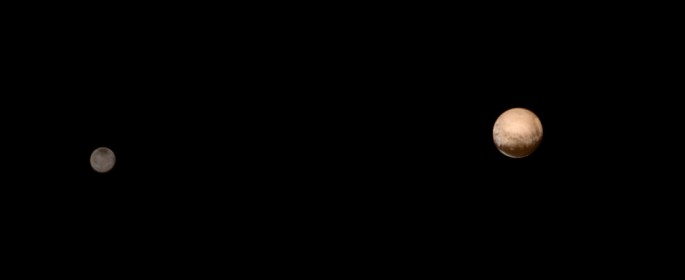As NASA's New Horizons probe zooms in closer to Pluto, new photos captured by the spacecraft reveals intense detail of Pluto and its largest moon, Charon.
These new images were taken last Wednesday, July 8, from a distance of 3.7 million miles, the closest photos of Pluto ever taken by the spacecraft. The images clearly present that Pluto and Charon are two entirely different bodies where they apparently share a common center of gravity separated by 12,200 miles.
According to New Horizons principal investigator Alan Stern from the Southwest Research Institute in Colorado, these two planetary objects have been sharing the same orbit for billions of years yet they are totally different from each other.
Charon is measured at 750 miles in diameter and is half as wide as Pluto where many researchers consider the two objects as a binary system since their center of mass is located just outside the dwarf planet. Apart from Charon, Pluto has also four other moons namely, Nix, Hydra, Kerberos and Styx that are really tiny.
Scientists believe that this binary system was formed long ago due to a massive collision of proto versions of Pluto and Charon. Based on recent data and images of Pluto and Charon, it is also safe to assume that these two objects' infant versions are also vastly different from each other.
Pluto reveals a reddish orange hue that is similar to a paler Mars while Charon is gray like our moon. Recent observations from New Horizons leading up to the much anticipated July 14 flyby reveal these two different colors including a diverse mix of dark and bright features such as a giant heart shaped marking on Pluto.
Charon on the other hand, looks more uniform in geology apart from a mysterious dark polar region. These new photos also reveal some light patches on Charon that are probably craters, according to mission controllers.
According to Jeff Moore from NASA's Ames Research Center in California, if there are visible impact craters on Charon, then these can provide a peek of what's hidden under its surface. Moore adds that larger craters can reveal an excavation of material about several miles deep, revealing the composition of Charon's interior.
According to GGI team leader John Spencer from the Southwest Research Institute in Colorado, Charon is now emerging as a whole new, different world where its personality is beginning to reveal itself, being vastly different from Pluto.
The epic July 14 flyby of New Horizons will show unprecedented views of Pluto from a distance of 7,800 miles which will capture the first ever closeup photos of the binary system.



























